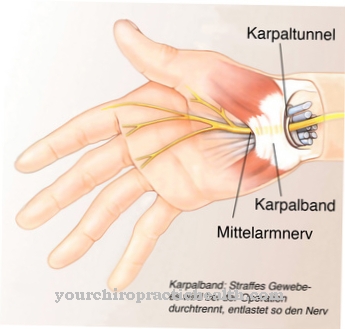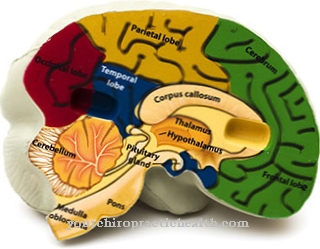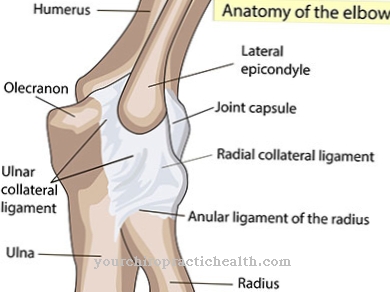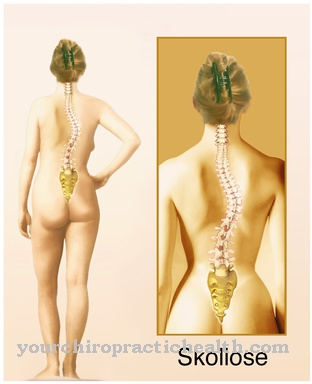A Lymphedema, caused by a disruption of the lymphatic system, usually occurs on the extremities (hands, feet, legs). However, it can affect other parts of the body as well. Treatment depends on the form and progress of the disease.
What is lymphedema?

© Ralf Geithe - stock.adobe.com
A Lymphoden is a visible and palpable swelling of a part of the body and is caused by a congestion of the lymphatic fluid. The lymph fluid is responsible for the transport of lymph plasma and lymphocytes via the lymphatic system and the lymph nodes, the filter and purification stations for the lymph.
If this transport is disturbed, the fluid builds up in front of a lymph node and lymphedema develops.This is a protein-rich water retention that makes the affected part of the body swell up and look plump.
The most common areas of the body affected are arms and legs. The head, neck, trunk and genitals can also be affected.
Lymphedema is rather rare, with women nine times more likely to be affected than men.
Depending on the age of onset, a distinction is made between early lymphedema, which occurs between the ages of 15 and 20, and late lymphedema in those over 35 years of age. Late lymphedema is very rare.
causes
Basically a Lymphedema through closed lymphatic channels, which generate such a high pressure that the lymph fluid escapes into the surrounding body tissue.
In order to narrow down the causes more precisely, medicine differentiates between primary and secondary forms of lymphedema:
1. Primary lymphedema occurs without objective causes and is mostly limited to one extremity or is inherited and can occur from birth or develop in the course of life. Hereditary lymphedema is caused by a developmental disorder of the lymphatic system that can occur without further symptoms or accompanied by short stature, intellectual disabilities and obesity.
2. In secondary lymphedema, a cause can be identified, and the triggers are varied. In principle, injuries and the consequences of operations can be identified as causes. Cancer, blood congestion, inflammation of the lymphatic system and parasites are also possible causes.
Typical symptoms & signs
Symptoms of lymphedema can vary depending on which parts of the body are affected, but there are also symptoms that occur with all lymphedema. The area of the body in which the lymphatic congestion occurs is filled with fluid and swollen, the skin may be drawn in. At the beginning there is usually no pain.
Other symptoms can provide information as to whether the lymphedema is hereditary (primary lymphedema) or whether it was caused by an illness, injury or the like (secondary lymphedema). Primary lymphedema spreads from the bottom up, starting from the toes, over the foot and lower leg on both sides towards the thigh. In summer and in women during the day, the swelling is more pronounced.
The toes look square (box toes) and the skin cannot be lifted (Stemmer sign). As the disease progresses, the lymphedema can lead to deformity of the legs (elephantiasis) and the skin can be prone to warts and infections. Secondary lymphedema can be similar, but it causes different symptoms and travels from top to bottom from the armpit to the hand or from the groin to the foot. In secondary lymphedema, the front foot and toes are not affected by the lymphedema.
Diagnosis & course
A Lymphedema is easy to diagnose based on the symptoms present, but the doctor must differentiate between primary and secondary edema:
The primary lymphedema on the leg is clearly evident on the affected toes. Secondary lymphedema must be investigated for its cause. This is done by means of blood analysis, ultrasound and an examination of the lymphatic transport, called lymph drainage scintigraphy. In the past, the lymphatic system was x-rayed using contrast media, but this diagnosis is rarely carried out today.
Complications
In most cases, lymphedema causes discomfort and complications in the extremities. The lymph nodes swell up relatively strongly and lymphatic congestion can also occur. The affected regions of the body are swollen, which can lead to various complaints and restrictions in the patient's everyday life.
In most cases, lymphedema also leads to water retention, which can appear in different parts of the body. In some cases, pain in the extremities can also occur, so that the person affected suffers from significant restrictions in everyday life and in carrying out normal activities. Lymphedema can be identified relatively easily, however, so that treatment can also take place quickly and early.
Treatment of the lymphedema does not lead to further complications or discomfort. The symptoms themselves can be limited by the treatment. As a rule, however, treatment of the underlying disease is still necessary so that these symptoms do not recur. The life expectancy of the patient is not reduced by this disease. In many cases, however, the patients are dependent on various exercises.
When should you go to the doctor?
If there is swelling, pain, feelings of pressure and tension, and other signs of lymphedema, this should be examined by a doctor. A dermatologist should clarify unusual skin changes, especially if there is sudden pain, redness, or swelling. If a rose forms, this indicates that the disease is already well advanced. Those affected should see a doctor immediately and have the complaints clarified in order to avoid scarring and other possibly permanent complications.
In the worst case, lymphedema can lead to fistula formation, edema and nerve disorders. Growths and circulatory disorders are further warning signs that must be examined by the family doctor on the same day. With severe pain or restricted mobility, it is best to go to a hospital immediately or to call the emergency doctor. Further points of contact are internists, lymphologists and the responsible organ specialists. If mental problems arise as a result of the physical changes, a therapist can be called in in consultation with the family doctor.
Treatment & Therapy
Treating a Lymphedema depends on the cause and the stage of the disease to be determined in the diagnosis. A detailed diagnosis is therefore crucial for adequate treatment.
The basic treatment goal is the decongestion of the affected lymph node, which can be achieved by elevating the affected part of the body.
In addition, the patient should take care not to wear tight clothing and avoid injuries so as not to further strain the lymphatic system.
In the case of secondary lymphedema caused by diseases, the underlying disease must be treated in addition to treating the edema.
Primary lymphedema requires complex physical decongestive therapy from the pillars:
- Lymphatic drainage
- Compression of the affected body part, for example with compression stockings or boots.
- Decongestion by means of gymnastic exercises and preventive skin and foot care
Other therapy options include taking diuretics, long-term antibiotic treatment, and surgical repair of the affected lymphatic systems.
While there are good chances of recovery in the first and second stages, the patient must expect intensive and lengthy treatment in the third stage, the fibroma. In the fourth stage, lymphostatic elephantiasis, which is accompanied by thickening and hardening of the skin, lymphedema is irreversible, but the progression of the disease can be prevented.
You can find your medication here
➔ Medicines against edema and water retentionOutlook & forecast
The prognosis of lymphedema depends on the underlying disease and the cause of the disorder. If the causal disease can be cured, lymphedema regresses on its own. In the case of inflammation, medical care can usually relieve the symptoms. In these situations, the prognosis is usually favorable, as recovery is possible after a few weeks or months.
If cancer is diagnosed, the prospect of a cure is tied to treatment options and the stage of the disease. In particularly severe cases, the underlying disease leads to the premature death of the patient. If lymphedema develops as a result of obesity, in many cases the symptoms can be alleviated without medical care. Weight loss often leads to improvements in overall health. If the person concerned suffers from a developmental disorder of the lymphatic system, the prognosis for a large number of patients is unfavorable. There is an impairment of the organism that lasts for life.
In principle, lymphedema should be treated medically so that it stabilizes and, if possible, improves health. Otherwise there will be restrictions in the range of motion and often an increase in the existing complaints. Pain worsens the quality of life and can increase the risk of secondary diseases.
prevention
It is not possible to be a primary Lymphedema to prevent. However, the risk of acquiring secondary lymphedema can be significantly reduced by avoiding obesity and regular examinations of the lymphatic system. It is also the task of a doctor operating on cancer to injure the lymphatic system as little as possible, even if the lymph nodes have to be removed.
Aftercare
The extent of the aftercare depends on the fact that led to the development of lymphedema. In mild cases, this is limited to a few repeat appointments with the responsible doctor after the acute treatment in order to guarantee a positive recovery process. The instructions must be followed. Sometimes a diet is necessary, which should be strictly followed and medically monitored. It may also be necessary to take tablets, whereby the prescribed dosage must be observed.
If there is a fundamentally serious illness that could lead to the development of lymphedema, it is important to curb this possibility through appropriate treatment. Those affected are therefore advised to report possible changes to their body to the doctor at an early stage in order to avert further complications or complaints.
You can do that yourself
When treating lymphedema, those affected can take some measures themselves to alleviate the symptoms. The stimulation of the metabolism and blood circulation is of fundamental importance. Only in this way can the lymph flow and the associated detoxification of the organism be stimulated. If waste products and other waste products of the metabolism are sufficiently removed, this increases general well-being.
Self-help measures can easily be integrated into everyday life as rituals. So the morning can be started with a brush massage. Brushing is always done in the direction of the heart. The massage stimulates blood and lymph flow. Then stimulating oils (ginger) can be massaged into the skin. This also strengthens the connective tissue. Adequate exercise is also fundamentally important when treating lymphedema. Swimming is particularly suitable. Through the movements in the water, both arterial and venous blood and lymph vessels are demonstrably trained, strengthened and regenerated. The affected body regions should also be raised as often as possible. This will facilitate the blood and lymph flow.
Furthermore, tight-fitting clothing should be avoided, as this puts additional strain on the lymphatic system. Wearing compression stockings, on the other hand, is a very good treatment aid. Naturopathy recommends the accompanying intake of five globules of Lycopodium clavatum C5 and ginko bioba three times a day. Both facilitate the drainage of lymphatic fluid.






.jpg)






.jpg)

.jpg)
.jpg)











.jpg)